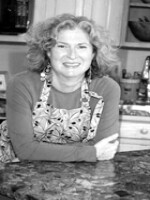The ancients really knew how to celebrate a change of seasons. And the transition from winter to spring was cause for serious celebration.
Most cultures in the ancient Mediterranean region had big celebrations at the spring equinox. People of Persian descent have kept the party going for 3,000 years or so.
Nowruz, the Persian New Year, begins at the exact moment of the vernal equinox, when the sun crosses the equator and winter ends. The festivities continue for 13 days.
Nowruz is not a religious holiday. It celebrates fertility and renewal with singing and dancing, visiting friends and relatives, and lots of feasting. It's got it all: myth and symbolism, fragrant hyacinth and Persian poetry, magic numbers and magic puddings.
Najmieh Batmanglij lives in Washington, D.C., but grew up in Iran. She has written several Persian cookbooks including her latest, Happy Nowruz: Cooking with Children to Celebrate the Persian New Year.
Batmanglij prepares the same spring foods for Nowruz every year. Everything is cooked with loads of fresh, spring herbs. She begins and ends the holiday with a soup with noodles that symbolize unraveling the difficulties in the year to come. Cooked with fresh dill, parsley and four pounds of spinach, it tastes like a bowl of spring.
Eggs, of course, represent fertility. So herb kuku with its dozen eggs and six cups of herbs covers all bases. Batmanglij also makes green rice, loaded with herbs and prepared with fresh fava beans. And there is always fish. "It is very important," she says. "It represents abundance."
Throughout the holiday, there are plenty of pastries — baklava soaked with rosewater and honey, tiny marzipan berries with a sliver of pistachio for stems, honey almond crunch with saffron, rice cookies with poppy seeds and cloverleaf-shaped chickpea cookies with cardamom.
Preparation for the New Year begins weeks in advance with serious spring cleaning, haircuts and new clothes. Debts are paid and sprouts are planted. Everything gets a fresh start.
Contemporary religious holidays still have holdover symbols from pagan seasonal festivals. Think Easter eggs. The Jewish feast of Passover, commemorating the Jews' liberation from slavery in Egypt, takes place in the early spring. Probably not a coincidence.
Nowruz is full of symbols of spring and fertility. The number seven has been regarded as magical by Persians for centuries. So seven items, called haft-sinn, are placed on the special cloth Persians spread out for the holiday. Apples represent beauty; garlic is health and fertility; wild olives, fertility and love, and so on.
The holiday starts the last Tuesday night before the vernal equinox with chahar shanbeh suri, a festival of fire and festivity. In Iran, and some places in the U.S., a character in red called Hadji Firouz goes through the streets singing, beating a tambourine and announcing the arrival of the New Year.
Children dressed as ghosts go door-to-door banging on pots with spoons looking for treats. Sound familiar? The idea is to drive away evil spirits and be ready to start fresh.
Noodle soup and a bowl filled with, yes, seven kinds of nuts and dried fruits is set out after the "transition," when winter turns to spring.
The big meal the next day is a family feast, similar to the Passover seder or Easter brunch. Then for nearly two weeks, there are visits — and meals — with family and friends.
The holiday ends with an outdoor picnic on what is called Outdoor 13. Families head to a grassy spot, play games and eat kabobs, green rice and maybe more noodle soup. They bring with them the sprouts that have grown in their homes and toss them into the water of a pond or stream, throwing out any evil spirits and thoughts, starting the year fresh.
Bonny Wolf is author of Talking With My Mouth Full and host of "Kitchen Window," NPR's food podcast.
Copyright 2023 NPR. To see more, visit https://www.npr.org.


